height MERCEDES-BENZ GLC 2017 Owners Manual
[x] Cancel search | Manufacturer: MERCEDES-BENZ, Model Year: 2017, Model line: GLC, Model: MERCEDES-BENZ GLC 2017Pages: 374, PDF Size: 8.42 MB
Page 20 of 374
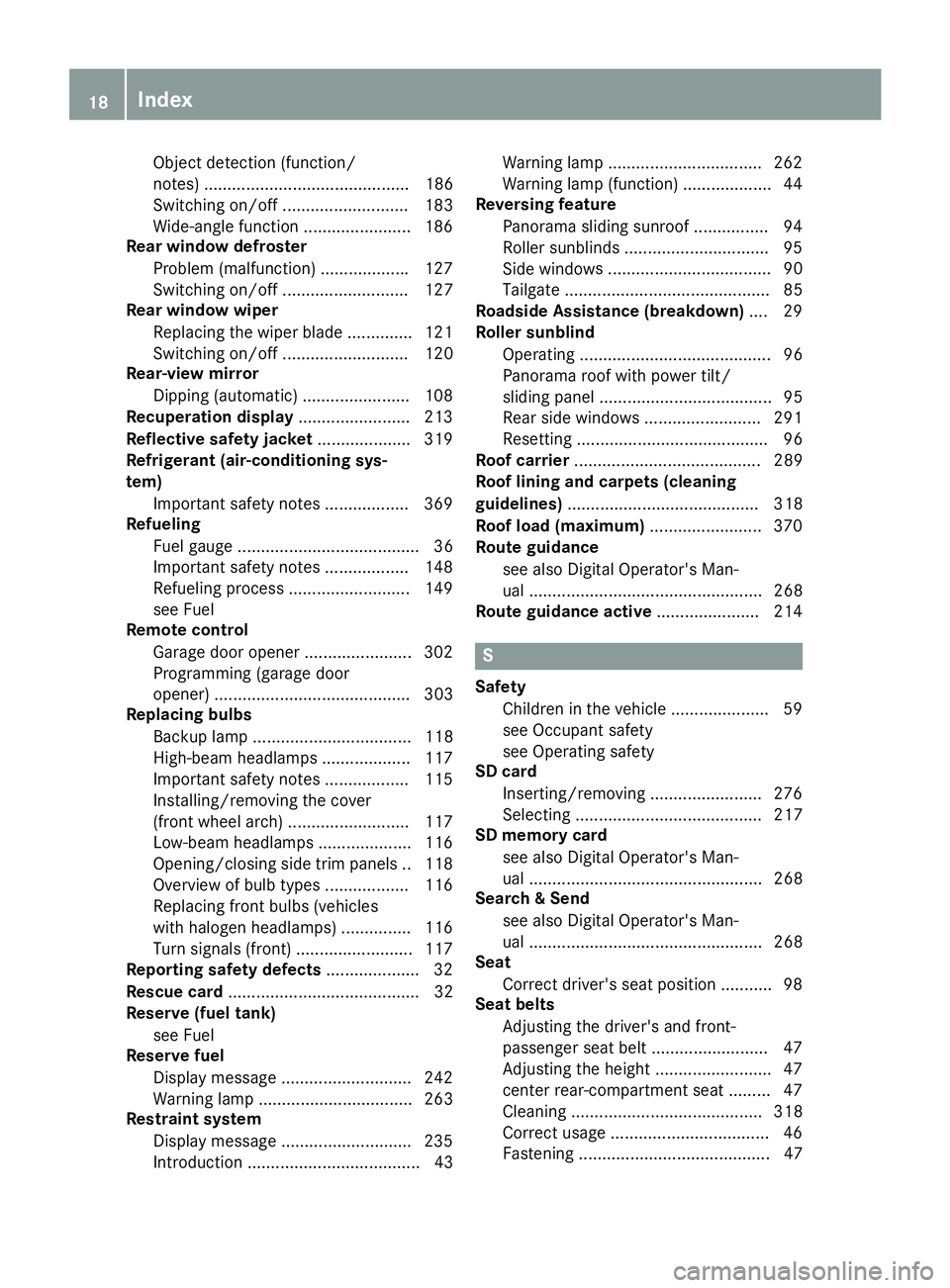
Object detection (function/
notes) ............................................ 186
Switching on/off ........................... 183
Wide-angle function ....................... 186
Rear window defroster
Problem (malfunction) .................. .1 27
Switching on/off ........................... 127
Rear window wiper
Replacing the wiper blade .............. 121
Switching on/off ........................... 120
Rear-view mirror
Dipping (automatic) ....................... 108
Recuperation display ........................ 213
Reflective safety jacket .................... 319
Refrigerant (air-conditioning sys-
tem)
Important safety notes .................. 369
Refueling
Fuel gauge ....................................... 36
Important safety notes .................. 148
Refueling process .......................... 149
see Fuel
Remote control
Garage door opener ....................... 302
Programming (garage door
opener) .......................................... 303
Replacing bulbs
Backup lamp .................................. 118
High-beam headlamps ................... 117
Important safety notes .................. 115
Installing/removing the cover
(front wheel arch) .......................... 117
Low-beam headlamps .................... 116
Opening/closing side trim panel s. .1 18
Overview of bulb types .................. 116
Replacing front bulbs (vehicles
with halogen headlamps) ............... 116
Turn signals (front) ......................... 117
Reporting safety defects .................... 32
Rescue card ......................................... 32
Reserve (fuel tank)
see Fuel
Reserve fuel
Display message ............................ 242
Warning lamp ................................. 263
Restraint system
Display message ............................ 235
Introduction ..................................... 43 Warning lamp ................................. 262
Warning lamp (function) ................... 44
Reversing feature
Panorama sliding sunroof ................ 94
Roller sunblinds ............................... 95
Side window s ................................... 90
T ai
lgate ............................................ 85
Roadside Assistance (breakdown) .... 29
Roller sunblind
Operating ......................................... 96
Panorama roof with power tilt/
sliding panel ..................................... 95
Rear side windows ......................... 291
Resetting ......................................... 96
Roof carrier ........................................ 289
Roof lining and carpets (cleaning
guidelines) ......................................... 318
Roof load (maximum) ........................ 370
Route guidance
see also Digital Operator's Man-
ual .................................................. 268
Route guidance active ...................... 214
S Safety
Children in the vehicle ..................... 59
see Occupant safety
see Operating safety
SD card
Inserting/removing ........................ 276
Selecting ........................................ 217
SD memory card
see also Digital Operator's Man-
ual .................................................. 268
Search & Send
see also Digital Operator's Man-
ual .................................................. 268
Seat
Correct driver's seat position ........... 98
Seat belts
Adjusting the driver's and front-
passenger seat belt ......................... 47
Adjusting the height ......................... 47
center rear-compartment seat ......... 47
Cleaning ......................................... 318
Correct usage .................................. 46
Fastening ......................................... 4718
Index
Page 47 of 374
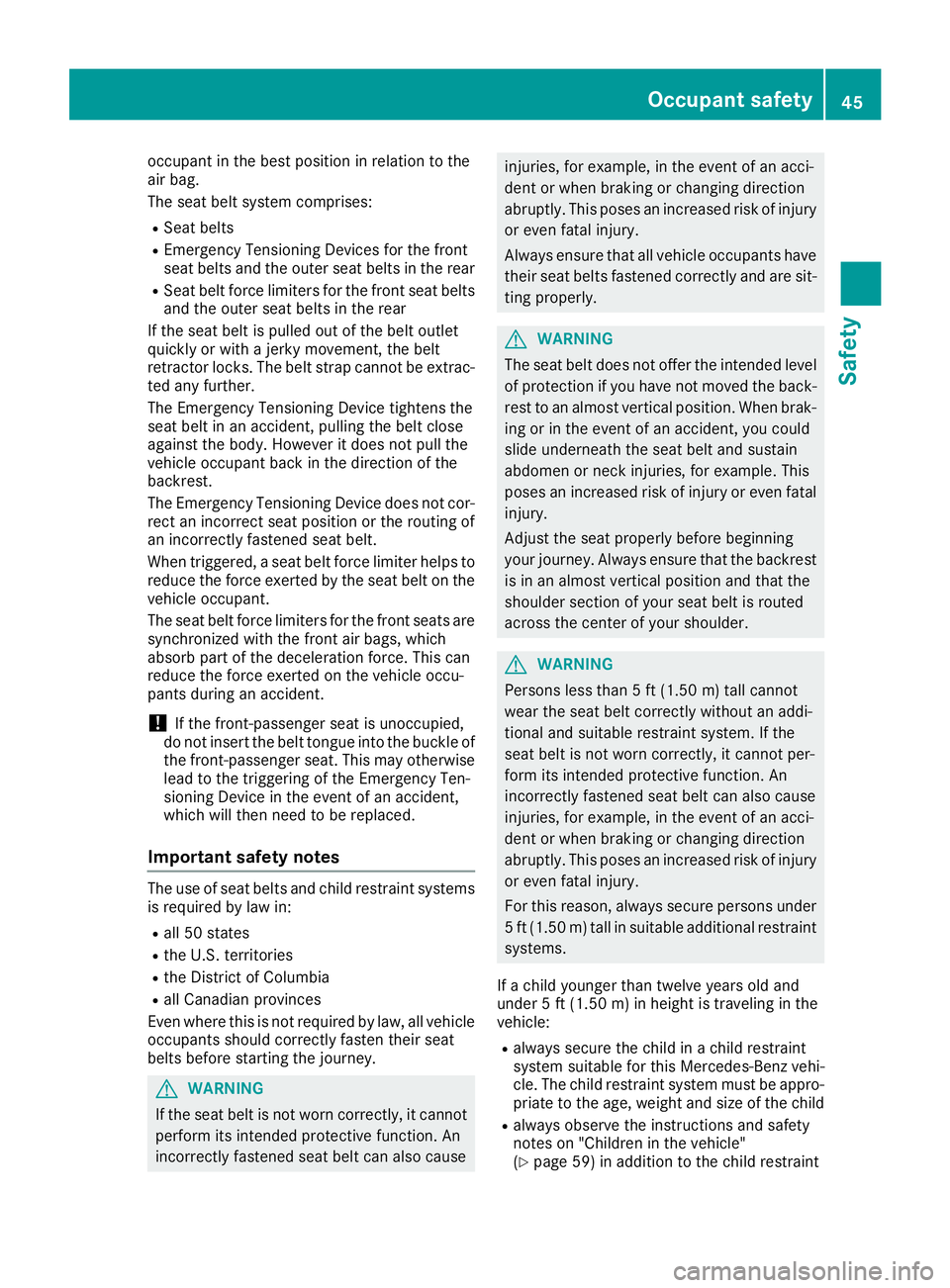
occupant in the best position in relation to the
air bag.
The seat belt system comprises: R
Seat belts R
Emergency Tensioning Devices for the front
seat belts and the outer seat belts in the rear R
Seat belt force limiters for the front seat belts
and the outer seat belts in the rear
If the seat belt is pulled out of the belt outlet
quickly or with a jerky movement, the belt
retractor locks. The belt strap cannot be extrac-
ted any further.
The Emergency Tensioning Device tightens the
seat belt in an accident, pulling the belt close
against the body. However it does not pull the
vehicle occupant back in the direction of the
backrest.
The Emergency Tensioning Device does not cor-
rect an incorrect seat position or the routing of
an incorrectly fastened seat belt.
When triggered, a seat belt force limiter helps to
reduce the force exerted by the seat belt on the
vehicle occupant.
The seat belt force limiters for the front seats are
synchronized with the front air bags, which
absorb part of the deceleration force. This can
reduce the force exerted on the vehicle occu-
pants during an accident.
! If the front-passenger seat is unoccupied,
do not insert the belt tongue into the buckle of
the front-passenger seat. This may otherwise
lead to the triggering of the Emergency Ten-
sioning Device in the event of an accident,
which will then need to be replaced.
Important safety notes The use of seat belts and child restraint systems
is required by law in: R
all 50 states R
the U.S. territories R
the District of Columbia R
all Canadian provinces
Even where this is not required by law, all vehicle
occupants should correctly fasten their seat
belts before starting the journey.
G WARNING
If the seat belt is not worn correctly, it cannot
perform its intended protective function. An
incorrectly fastened seat belt can also cause injuries, for example, in the event of an acci-
dent or when braking or changing direction
abruptly. This poses an increased risk of injury
or even fatal injury.
Always ensure that all vehicle occupants have
their seat belts fastened correctly and are sit-
ting properly.
G WARNING
The seat belt does not offer the intended level
of protection if you have not moved the back-
rest to an almost vertical position. When brak-
ing or in the event of an accident, you could
slide underneath the seat belt and sustain
abdomen or neck injuries, for example. This
poses an increased risk of injury or even fatal
injury.
Adjust the seat properly before beginning
your journey. Always ensure that the backrest
is in an almost vertical position and that the
shoulder section of your seat belt is routed
across the center of your shoulder.
G WARNING
Persons less than 5 ft (1.50 m) tall cannot
wear the seat belt correctly without an addi-
tional and suitable restraint system. If the
seat belt is not worn correctly, it cannot per-
form its intended protective function. An
incorrectly fastened seat belt can also cause
injuries, for example, in the event of an acci-
dent or when braking or changing direction
abruptly. This poses an increased risk of injury
or even fatal injury.
For this reason, always secure persons under
5 ft (1.50 m) tall in suitable additional restraint
systems.
If a child younger than twelve years old and
under 5 ft (1.50 m) in height is traveling in the
vehicle: R
always secure the child in a child restraint
system suitable for this Mercedes-Benz vehi-
cle. The child restraint system must be appro-
priate to the age, weight and size of the child R
always observe the instructions and safety
notes on "Children in the vehicle"
( Y
page 59) in addition to the child restraintOccupant safety 45
Safety Z
Page 48 of 374
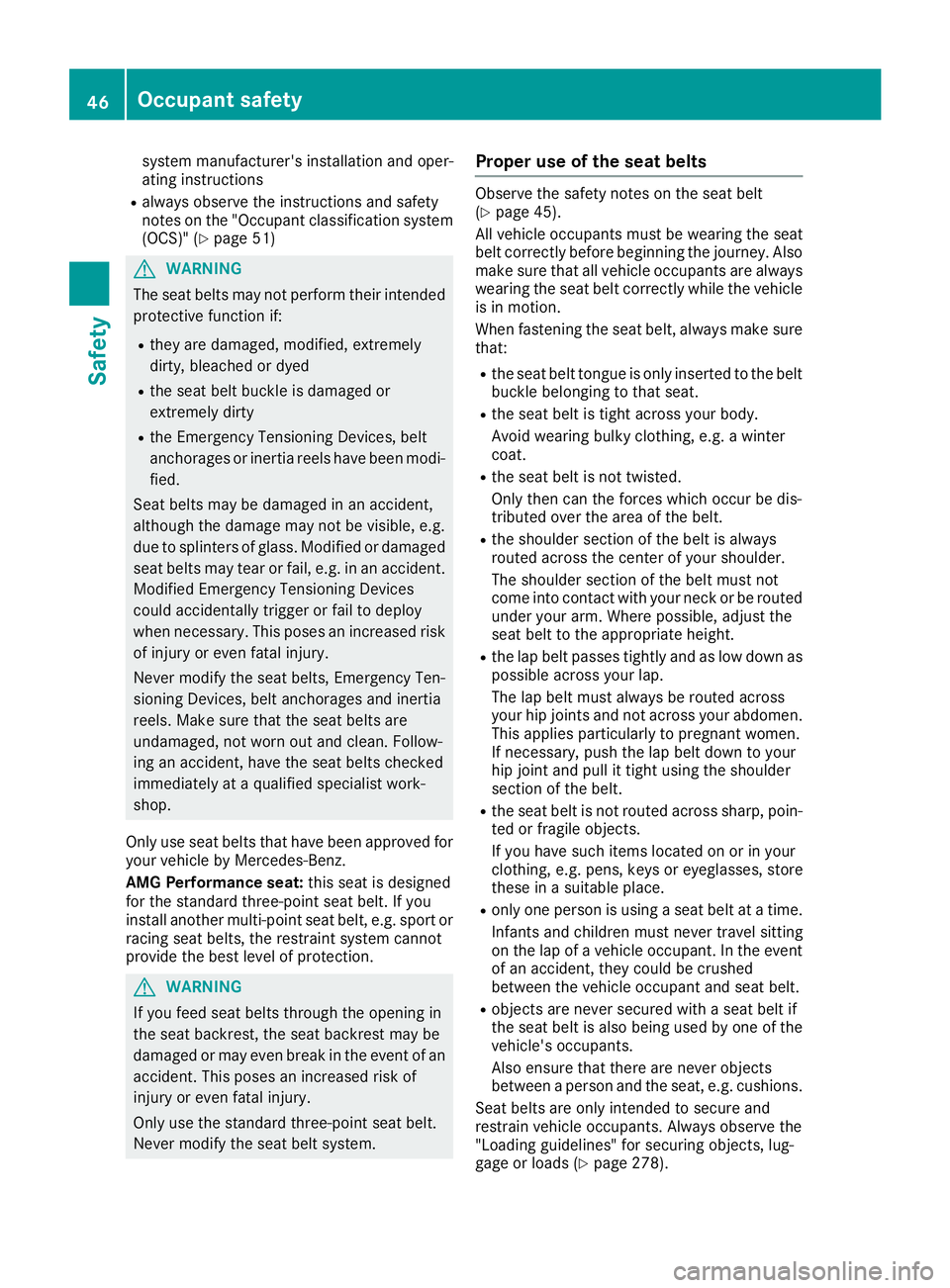
system manufacturer's installation and oper-
ating instructions R
always observe the instructions and safety
notes on the "Occupant classification system
(OCS)" ( Y
page 51)
G WARNING
The seat belts may not perform their intended
protective function if: R
they are damaged, modified, extremely
dirty, bleached or dyed R
the seat belt buckle is damaged or
extremely dirty R
the Emergency Tensioning Devices, belt
anchorages or inertia reels have been modi-
fied.
Seat belts may be damaged in an accident,
although the damage may not be visible, e.g.
due to splinters of glass. Modified or damaged
seat belts may tear or fail, e.g. in an accident.
Modified Emergency Tensioning Devices
could accidentally trigger or fail to deploy
when necessary. This poses an increased risk
of injury or even fatal injury.
Never modify the seat belts, Emergency Ten-
sioning Devices, belt anchorages and inertia
reels. Make sure that the seat belts are
undamaged, not worn out and clean. Follow-
ing an accident, have the seat belts checked
immediately at a qualified specialist work-
shop.
Only use seat belts that have been approved for
your vehicle by Mercedes-Benz.
AMG Performance seat: this seat is designed
for the standard three-point seat belt. If you
install another multi-point seat belt, e.g. sport or
racing seat belts, the restraint system cannot
provide the best level of protection.
G WARNING
If you feed seat belts through the opening in
the seat backrest, the seat backrest may be
damaged or may even break in the event of an
accident. This poses an increased risk of
injury or even fatal injury.
Only use the standard three-point seat belt.
Never modify the seat belt system. Proper use of the seat belts Observe the safety notes on the seat belt
( Y
page 45).
All vehicle occupants must be wearing the seat
belt correctly before beginning the journey. Also
make sure that all vehicle occupants are always
wearing the seat belt correctly while the vehicle
is in motion.
When fastening the seat belt, always make sure
that: R
the seat belt tongue is only inserted to the belt
buckle belonging to that seat. R
the seat belt is tight across your body.
Avoid wearing bulky clothing, e.g. a winter
coat. R
the seat belt is not twisted.
Only then can the forces which occur be dis-
tributed over the area of the belt. R
the shoulder section of the belt is always
routed across the center of your shoulder.
The shoulder section of the belt must not
come into contact with your neck or be routed
under your arm. Where possible, adjust the
seat belt to the appropriate height. R
the lap belt passes tightly and as low down as
possible across your lap.
The lap belt must always be routed across
your hip joints and not across your abdomen.
This applies particularly to pregnant women.
If necessary, push the lap belt down to your
hip joint and pull it tight using the shoulder
section of the belt. R
the seat belt is not routed across sharp, poin-
ted or fragile objects.
If you have such items located on or in your
clothing, e.g. pens, keys or eyeglasses, store
these in a suitable place. R
only one person is using a seat belt at a time.
Infants and children must never travel sitting
on the lap of a vehicle occupant. In the event
of an accident, they could be crushed
between the vehicle occupant and seat belt. R
objects are never secured with a seat belt if
the seat belt is also being used by one of the
vehicle's occupants.
Also ensure that there are never objects
between a person and the seat, e.g. cushions.
Seat belts are only intended to secure and
restrain vehicle occupants. Always observe the
"Loading guidelines" for securing objects, lug-
gage or loads ( Y
page 278).46
Occupant safety
Safety
Page 50 of 374
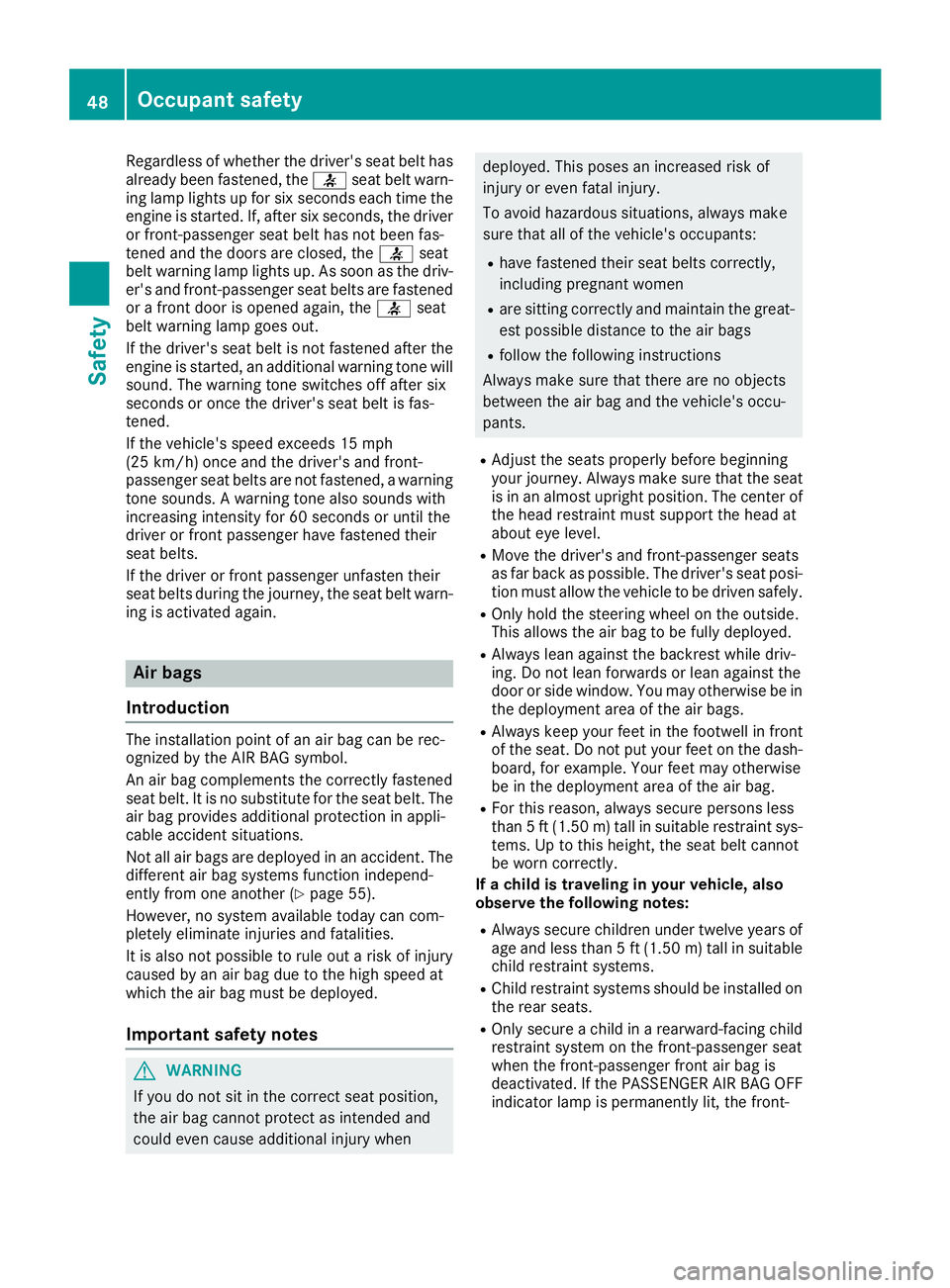
Regardles s of whether th e driver' s seat belt has
already been fastened, th e �v seat belt warn -
ing lamp lights up for six seconds eac h time th e
engin e is started. If , after six seconds, th e driver
or front-passenger seat belt has no t been fas -
tene d and th e door s are closed, th e �v seat
belt warning lamp lights up. As soo n as th e driv -
er' s and front-passenger seat belt s are fastene d
or a fron t door is opened again , th e �v seat
belt warning lamp goes out .
If th e driver' s seat belt is no t fastene d after th e
engin e is started, an additional warning tone will
sound. The warning tone switches off after six
seconds or once th e driver' s seat belt is fas -
tened.
If th e vehicle's spee d exceeds 15 mph
(25 km/h) once and th e driver' s and front-
passenger seat belt s are no t fastened, a warning
tone sounds. A warning tone also sounds wit h
increasing intensit y for 60 seconds or until th e
driver or fron t passenger hav e fastene d their
seat belts.
If th e driver or fron t passenger unfasten their
seat belt s during th e journey, th e seat belt warn -
ing is activated again .
Air bags
Introduction The installation poin t of an air bag can be rec -
ognized by th e AI R BA G symbol.
An air bag complements th e correctl y fastene d
seat belt . It is no substitut e for th e seat belt . The
air bag provide s additional protection in appli-
cable acciden t situations.
Not all air bags are deployed in an accident. The
differen t air bag systems function independ-
entl y from on e another ( Y
page 55).
However, no system available today can com-
pletely eliminate injurie s and fatalities.
It is also no t possibl e to rule out a ris k of injury
caused by an air bag due to th e high spee d at
whic h th e air bag mus t be deployed.
Important safety notes
G WARNIN G
If you do no t sit in th e correc t seat position ,
th e air bag canno t protect as intended and
could eve n caus e additional injury when deployed. This poses an increased ris k of
injury or eve n fatal injury.
To avoi d hazardous situations, always mak e
sur e that all of th e vehicle's occupants: R
hav e fastene d their seat belt s correctly,
includin g pregnant women R
are sitting correctl y and maintai n th e great-
est possibl e distanc e to th e air bagsR
follow th e followin g instruction s
Always mak e sur e that there are no objects
between th e air bag and th e vehicle's occu-
pants . R
Adjus t th e seat s properly before beginning
your journey. Always mak e sur e that th e seat
is in an almost upright position . The center of
th e head restrain t mus t support th e head at
about eye level. R
Mov e th e driver' s and front-passenger seat s
as far bac k as possible. The driver' s seat posi-
tion mus t allow th e vehicl e to be driven safely.R
Only hold th e steering whee l on th e outside .
This allows th e air bag to be fully deployed. R
Always lean against th e backrest while driv -
ing . Do no t lean forwards or lean against th e
door or side window. You may otherwise be in
th e deploymen t area of th e air bags .R
Always keep your fee t in th e footwell in fron t
of th e seat . Do no t put your fee t on th e dash -
board, for example. Your fee t may otherwise
be in th e deploymen t area of th e a ir bag.R
Fo r this reason , always secure person s less
than 5 ft (1.5 0 m) tall in suitable restraint sys-
tems. Up to this height, the seat belt cannot
be worn correctly.
If a child is traveling in your vehicle, also
observe the following notes: R
Always secure children under twelve years of
age and less than 5 ft (1.50 m) tall in suitable
child restraint systems. R
Child restraint systems should be installed on
the rear seats. R
Only secure a child in a rearward-facing child
restraint system on the front-passenger seat
when the front-passenger front air bag is
deactivated. If the PASSENGER AIR BAG OFF
indicator lamp is permanently lit, the front-48
Occupant safety
Safety
Page 61 of 374
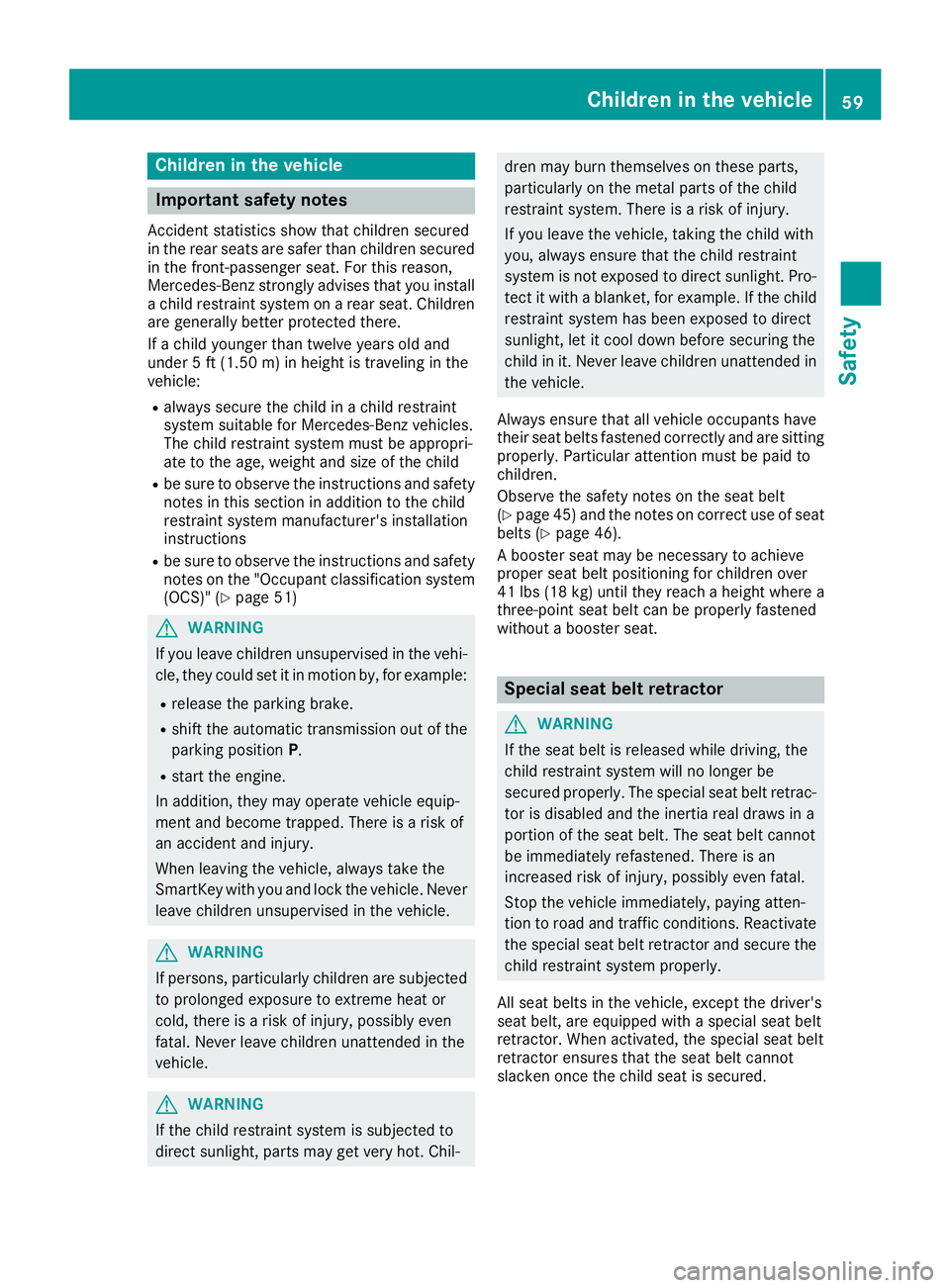
Children in the vehicle
Important safety notes Accident statistics show that children secured
in the rear seats are safer than children secured
in the front-passenger seat. For this reason,
Mercedes-Benz strongly advises that you install
a child restraint system on a rear seat. Children
are generally better protected there.
If a child younger than twelve years old and
under 5 ft (1.50 m) in height is traveling in the
vehicle: R
always secure the child in a child restraint
system suitable for Mercedes-Benz vehicles.
The child restraint system must be appropri-
ate to the age, weight and size of the child R
be sure to observe the instructions and safety
notes in this section in addition to the child
restraint system manufacturer's installation
instructions R
be sure to observe the instructions and safety
notes on the "Occupant classification system
(OCS)" ( Y
page 51)
G WARNING
If you leave children unsupervised in the vehi-
cle, they could set it in motion by, for example: R
release the parking brake. R
shift the automatic transmission out of the
parking position P .R
start the engine.
In addition, they may operate vehicle equip-
ment and become trapped. There is a risk of
an accident and injury.
When leaving the vehicle, always take the
SmartKey with you and lock the vehicle. Never
leave children unsupervised in the vehicle.
G WARNING
If persons, particularly children are subjected
to prolonged exposure to extreme heat or
cold, there is a risk of injury, possibly even
fatal. Never leave children unattended in the
vehicle.
G WARNING
If the child restraint system is subjected to
direct sunlight, parts may get very hot. Chil- dren may burn themselves on these parts,
particularly on the metal parts of the child
restraint system. There is a risk of injury.
If you leave the vehicle, taking the child with
you, always ensure that the child restraint
system is not exposed to direct sunlight. Pro-
tect it with a blanket, for example. If the child
restraint system has been exposed to direct
sunlight, let it cool down before securing the
child in it. Never leave children unattended in
the vehicle.
Always ensure that all vehicle occupants have
their seat belts fastened correctly and are sitting
properly. Particular attention must be paid to
children.
Observe the safety notes on the seat belt
( Y
page 45 )a nd the notes on correct use of seat
belts ( Y
page 46).
A booster seat may be necessary to achieve
proper seat belt positioning for children over
41 lb s( 18 kg) until they reach a height where a
three-point seat belt can be properly fastened
without a booster seat.
Special seat belt retractor
G WARNING
If the seat belt is released while driving, the
child restraint system will no longer be
secured properly. The special seat belt retrac-
tor is disabled and the inertia real draws in a
portion of the seat belt. The seat belt cannot
be immediately refastened. There is an
increased risk of injury, possibly even fatal.
Stop the vehicle immediately, paying atten-
tion to road and traffic conditions. Reactivate
the special seat belt retractor and secure the
child restraint system properly.
All seat belts in the vehicle, except the driver's
seat belt, are equipped with a special seat belt
retractor. When activated, the special seat belt
retractor ensures that the seat belt cannot
slacken once the child seat is secured.Children in the vehicle 59
Safety Z
Page 101 of 374
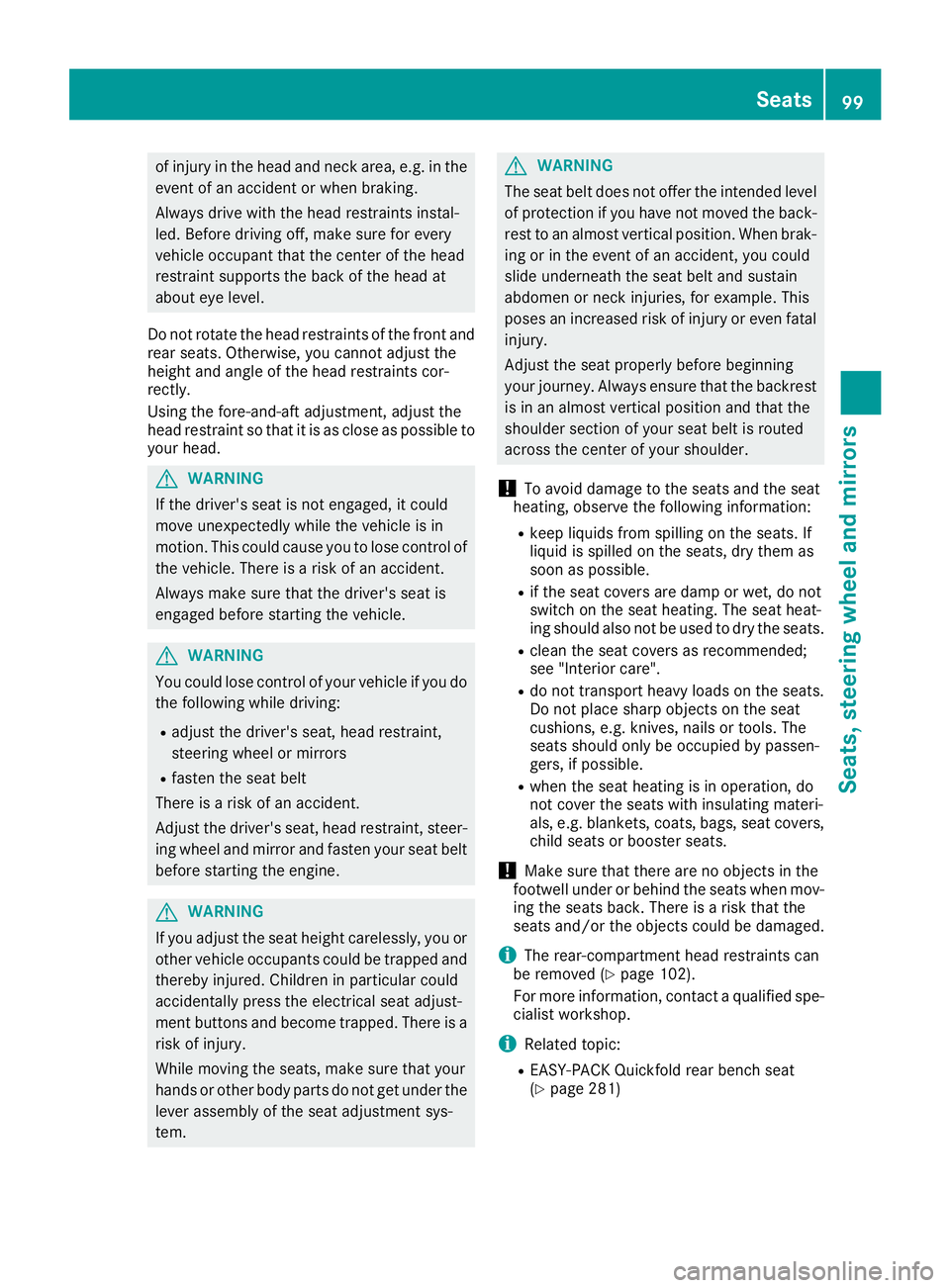
of injury in the head and neck area, e.g. in the
event of an accident or when braking.
Always drive with the head restraints instal-
led. Before driving off, make sure for every
vehicle occupant that the center of the head
restraint supports the back of the head at
about eye level.
Do not rotate the head restraints of the front and
rear seats. Otherwise, you cannot adjust the
height and angle of the head restraints cor-
rectly.
Using the fore-and-aft adjustment, adjust the
head restraint so that it is as close as possible to
your head.
G WARNING
If the driver's seat is not engaged, it could
move unexpectedly while the vehicle is in
motion. This could cause you to lose control of
the vehicle. There is a risk of an accident.
Always make sure that the driver's seat is
engaged before starting the vehicle.
G WARNING
You could lose control of your vehicle if you do
the following while driving: R
adjust the driver's seat, head restraint,
steering wheel or mirrors R
fasten the seat belt
There is a risk of an accident.
Adjust the driver's seat, head restraint, steer-
ing wheel and mirror and fasten your seat belt
before starting the engine.
G WARNING
If you adjust the seat height carelessly, you or
other vehicle occupants could be trapped and
thereby injured. Children in particular could
accidentally press the electrical seat adjust-
ment buttons and become trapped. There is a
risk of injury.
While moving the seats, make sure that your
hands or other body parts do not get under the
lever assembly of the seat adjustment sys-
tem. G WARNING
The seat belt does not offer the intended level
of protection if you have not moved the back-
rest to an almost vertical position. When brak-
ing or in the event of an accident, you could
slide underneath the seat belt and sustain
abdomen or neck injuries, for example. This
poses an increased risk of injury or even fatal
injury.
Adjust the seat properly before beginning
your journey. Always ensure that the backrest
is in an almost vertical position and that the
shoulder section of your seat belt is routed
across the center of your shoulder.
! To avoid damage to the seats and the seat
heating, observe the following information: R
keep liquids from spilling on the seats. If
liquid is spilled on the seats, dry them as
soon as possible. R
if the seat covers are damp or wet, do not
switch on the seat heating. The seat heat-
ing should also not be used to dry the seats. R
clean the seat covers as recommended;
see "Interior care". R
do not transport heavy loads on the seats.
Do not place sharp objects on the seat
cushions, e.g. knives, nails or tools. The
seats should only be occupied by passen-
gers, if possible. R
when the seat heating is in operation, do
not cover the seats with insulating materi-
als, e.g. blankets, coats, bags, seat covers,
child seats or booster seats.
! Make sure that there are no objects in the
footwell under or behind the seats when mov-
ing the seats back. There is a risk that the
seats and/or the objects could be damaged.
i The rear-compartment head restraints can
be removed ( Y
page 102).
For more information, contact a qualified spe-
cialist workshop.
i Related topic: R
EASY-PACK Quickfold rear bench seat
( Y
page 281) Seats 99
Seats, steering wheel and mirrors Z
Page 102 of 374
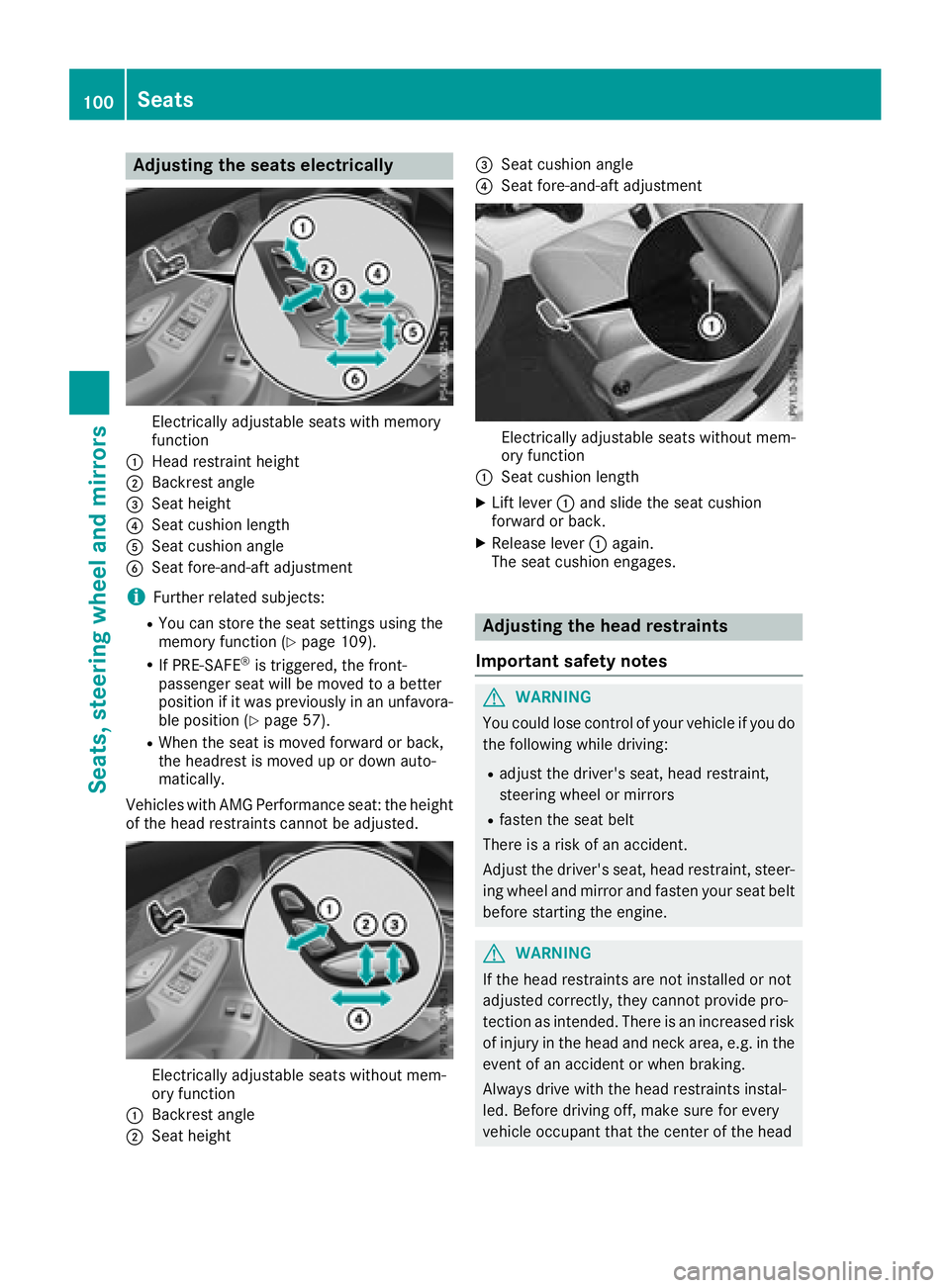
Adjusting the seats elect ri cally
Electrically adjustable seat s wit h memory
function�C
Hea d restrain t height�D
Backrest angle�
Page 103 of 374
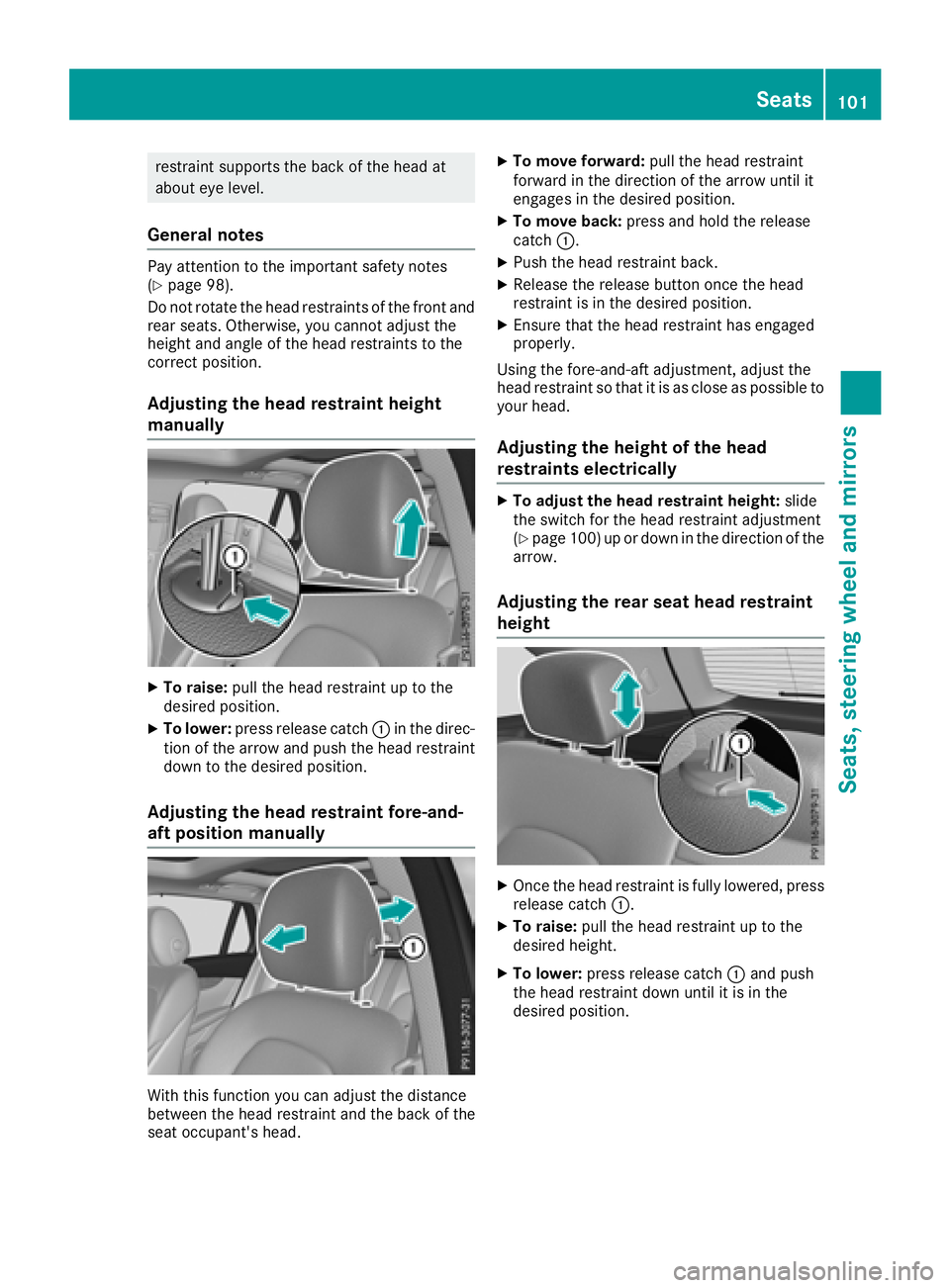
restraint supports the back of the head at
about eye level.
General notes Pay attention to the important safety notes
( Y
page 98).
Do not rotate the head restraints of the front and
rear seats. Otherwise, you cannot adjust the
height and angle of the head restraints to the
correct position.
Adjusting the head restraint height
manually
X
To raise: pull the head restraint up to the
desired position. X
To lower: press release catch �C in the direc-
tion of the arrow and push the head restraint
down to the desired position.
Adjusting the head restraint fore-and-
aft position manually
With this function you can adjust the distance
between the head restraint and the back of the
seat occupant's head. X
To move forward: pull the head restraint
forward in the direction of the arrow until it
engages in the desired position. X
To move back: press and hold the release
catch �C . X
Push the head restraint back. X
Release the release button once the head
restraint is in the desired position. X
Ensure that the head restraint has engaged
properly.
Using the fore-and-aft adjustment, adjust the
head restraint so that it is as close as possible to
your head.
Adjusting the height of the head
restraints electrically X
To adjust the head restraint height: slide
the switch for the head restraint adjustment
( Y
page 100) up or down in the direction of the
arrow.
Adjusting the rear seat head restraint
height
X
Once the head restraint is fully lowered, press
release catch �C . X
To raise: pull the head restraint up to the
desired height. X
To lower: press release catch �C and push
the head restraint down until it is in the
desired position. Seats 101
Seats, steering wheel and mirrors Z
Page 106 of 374
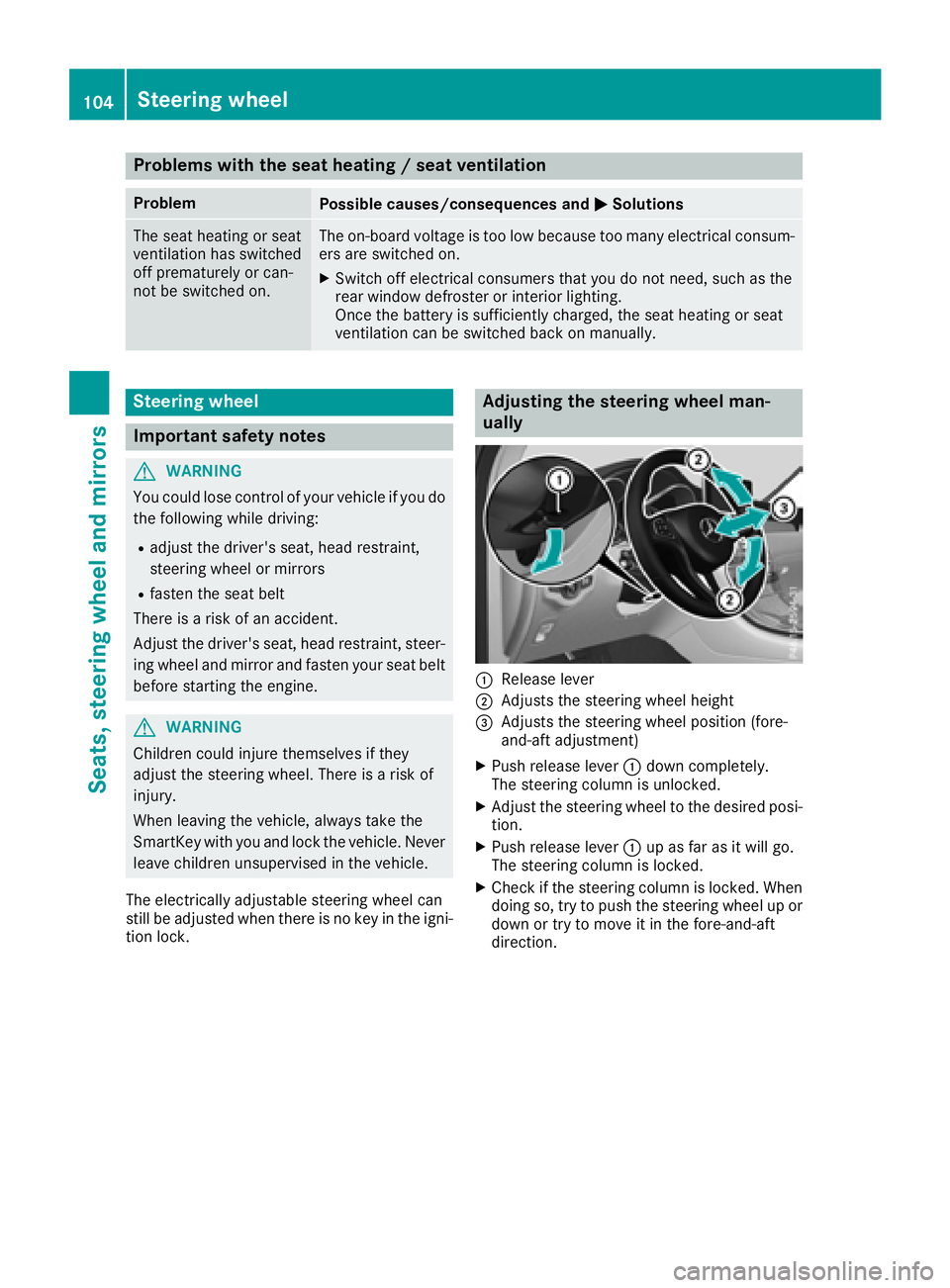
Problems with the seat heating / seat ventilation Problem
Possible causes/consequences and �P Solutions
The seat heating or seat
ventilation has switched
off prematurely or can-
not be switched on. The on-board voltage is too low because too many electrical consum-
ers are switched on. X
Switch off electrical consumers that you do not need, such as the
rear window defroster or interior lighting.
Once the battery is sufficiently charged, the seat heating or seat
ventilation can be switched back on manually.
Steering wheel
Important safety notes
G WARNING
You could lose control of your vehicle if you do
the following while driving: R
adjust the driver's seat, head restraint,
steering wheel or mirrors R
fasten the seat belt
There is a risk of an accident.
Adjust the driver's seat, head restraint, steer-
ing wheel and mirror and fasten your seat belt
before starting the engine.
G WARNING
Children could injure themselves if they
adjust the steering wheel. There is a risk of
injury.
When leaving the vehicle, always take the
SmartKey with you and lock the vehicle. Never
leave children unsupervised in the vehicle.
The electrically adjustable steering wheel can
still be adjusted when there is no key in the igni-
tion lock. Adjusting the steering wheel man-
ually
�C
Release lever �D
Adjusts the steering wheel height �
Page 107 of 374
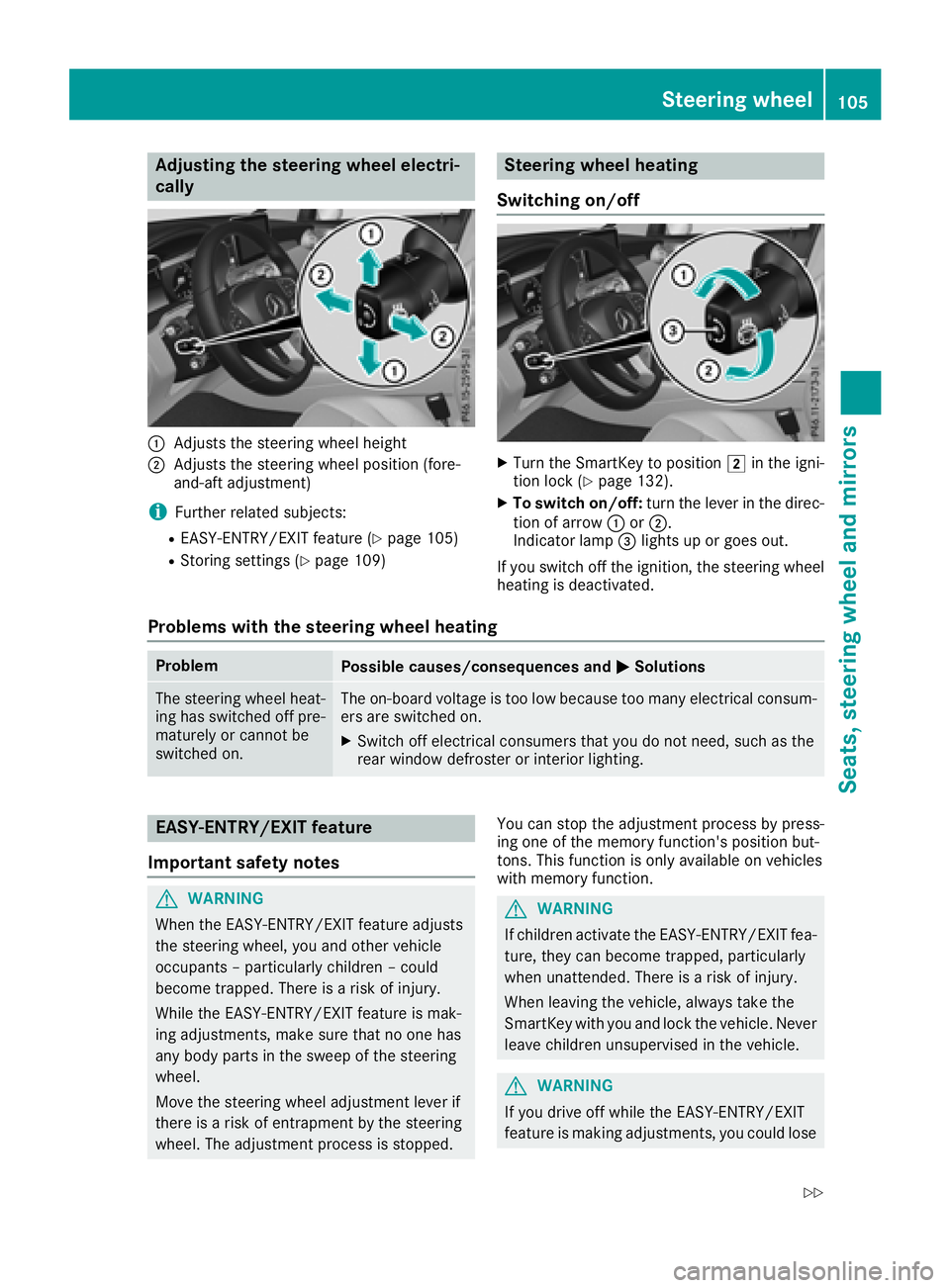
Adjusting the steering wheel elect ri -
cally
�C
Adjusts th e steering whee l height�D
Adjusts th e steering whee l position (fore-
and-af t adjustment)
i Further relate d subjects :R
EASY-ENTRY/EXIT feature ( Y
page 105)R
Storing setting s ( Y
page 109) Steering wheel heating
Switching on/off X
Turn th e SmartKey to position �H in th e igni-
tion loc k ( Y
page 132). X
To switch on/off: tur n th e lever in th e direc -
tion of arrow �C or �D .
Indicato r lamp �